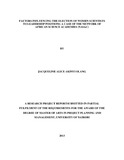| dc.description.abstract | Science academies hold elections to select and appoint members to leadership
positions within their governance structures. It is noteworthy these elections result in a
majority of the leadership positions taken up by male scientists and rarely women scientists.
This study attempts to establish the factors that influence the election of women scientists to
leadership positions within the membership of the Network of African Science Academies
(NASAC). The world's academies of science, engineering, and medicine must take
immediate action to remedy the widespread, persistent and wasteful under representation of
women in scientific and technological fields. In 2013, out of the nineteen members of
NASAC, only one of the science academies – the Tanzania Academy of Sciences – had
elected a woman scientist as its President. The question that begs to be asked is: What can a
Network like NASAC do to meet the demands for equality and equity in the election process
so as to increase the number of women scientists in leadership positions? The objectives of
this study focused on science academies and sought to: examine how level of education
influences the election of women scientists; establish how socio-economic background
influences the election of women to leadership positions; determine how the female
scientist’s level of awareness of the available leadership positions influences their election;
and lastly, assess to what extent prior positions held by female scientists influence the
election. For all purposes and intents, this study only covered the factors that influence the
election of women scientists to leadership positions within the membership of NASAC with a
using the survey research design on target population of 40 respondents with a focus on the
four main objectives. The survey instrument used was an interview schedule by which faceto-
face and online interviews were conducted. While several other major areas of disciplined
study and knowledge exist under the general rubric of "science", such as basic science and
applied science, this study focused on the leadership processes of science academies with a
special reference for women scientists. The study established that women scientists can serve
as role models and become instrumental in attracting and retaining young girls into scientific
fields and/or professions. The first major finding of the study was related to examining how
the level of education influence the election in to leadership positions of the women scientists
who participated as respondents. The second major finding was related to establishing how
the socio-economic background of the respondents influenced their election into leadership
positions within the academies. The third major finding was related to determining the level
of awareness of the respondents to the available leadership positions that women scientists
can vie for within the academies. The fourth major finding of the study was related to
assessing to what extent prior positions held by the women scientists influenced their election
to the leadership positions within the academies. The main recommendation of the study is
that science academies in general and NASAC in particular, should take cognizance of the
factors that influence the election of women scientists to leadership positions so as to
guarantee, at the very least, the availability of female scientists as role models. Further
research is however still necessary in finding the link between socio-economic background
and retention of women in scientific professions especially in Africa where the data on
women scientists is not readily available. | en |

